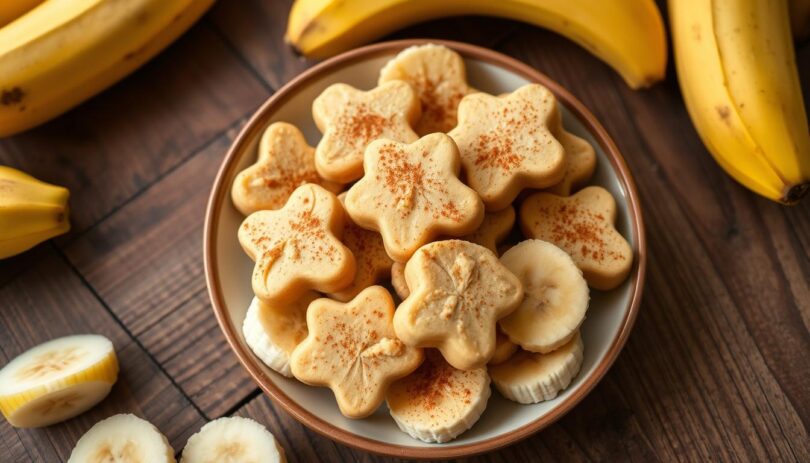What if your furry friend’s favorite snack could boost their health and wag their tail even faster? While many pet owners stick to commercial treats, nature offers simple solutions packed with nutrients. Let’s explore how one humble fruit can transform treat time.
Rich in potassium, vitamin B6, and fiber, this natural snack supports digestion and energy levels. Veterinarians often recommend it as an occasional addition to balanced diets. However, portion control matters—too much natural sugar can offset benefits.
Creative preparation makes all the difference. Mix mashed fruit with peanut butter for frozen delights, or blend into homemade biscuits. Always remove peels first, as they pose choking risks. Safety comes before novelty.
This guide shares vet-approved recipes and serving tips. You’ll learn to balance nutrition with flavor while avoiding common mistakes. Ready to turn kitchen scraps into tail-wagging joy? Let’s create treats that nourish body and bond.
Introduction to Banana Dog Treats
Pet parents are swapping processed snacks for wholesome ingredients, and one fruit stands out for its versatility. Unlike store-bought options loaded with preservatives, natural alternatives offer both flavor and functional benefits. But what elevates this particular choice above the rest?
What Makes These Fruit-Based Snacks Unique?
Most commercial treats prioritize shelf life over nutrition. Homemade versions using ripe fruit provide potassium, vitamin C, and magnesium—nutrients that support muscle function and immune health. Their soft texture also makes them ideal for older pets or those with dental sensitivities.
Fiber content aids digestion, but moderation is key. Too much can lead to stomach upset, so veterinarians suggest limiting portions to 2-3 small bites per serving. Pairing the fruit with unsweetened peanut butter adds protein while keeping tails wagging.
Balancing Nutrition and Safety
While the flesh is safe, peels should never be fed due to choking hazards and potential pesticide residue. Always slice treats into bite-sized pieces and supervise during snack time. This approach lets pets enjoy natural sweetness without risks.
Creative recipes transform simple ingredients into exciting rewards. Think frozen blends or baked biscuits—easy to customize for picky eaters. Always consult your vet before introducing new foods to ensure they align with your companion’s dietary needs.
Health Benefits and Nutritional Insights
Your canine companion’s snack time might be missing a key superfood. Packed with essential nutrients, this fruit-based treat delivers more than just flavor—it supports vital bodily functions through science-backed benefits.
Key Vitamins and Minerals
Potassium keeps muscles strong and nerves responsive, helping active pets maintain their energy. Vitamin B6 plays a starring role in metabolizing proteins and fats, ensuring your furry friend gets the most from their meals.
Vitamin C acts as an antioxidant, while fiber promotes smooth digestion. Magnesium quietly strengthens bones and aids in nutrient absorption. Together, these elements address common dietary gaps in modern pet foods.
Experts recommend pairing small portions with unsweetened peanut butter for added protein. A teaspoon-sized serving twice weekly balances nutrition without overloading on natural sugars. Always tailor quantities to your pal’s size and activity level.
How to Safely Serve Bananas to Your Dog
Treat time becomes safer when you follow science-backed guidelines. While this fruit offers nutritional perks, improper serving methods can undo its benefits. Let’s break down the essentials for risk-free snacking.
Portion Control and Serving Sizes
Small pets under 20 pounds thrive with teaspoon-sized portions twice weekly. Medium-sized companions (20-50 lbs) can handle up to two tablespoons, while larger breeds may enjoy a quarter of a mashed fruit. Treats should never exceed 10% of daily calories.
Puppies and seniors need smaller amounts due to sensitive digestion. Mix tiny bits into meals or use as training rewards. Always consult your vet if unsure—dietary needs vary by breed and health status.
Precautions With Banana Peels
The fibrous outer layer poses serious choking and blockage risks. Even organic peels may carry pesticides harmful to pets. Remove them completely before slicing the flesh into bite-sized pieces.
For picky eaters, blend the fruit into frozen yogurt drops or bake it into grain-free biscuits alongside other safe fruits. Store leftovers in airtight containers to maintain freshness without preservatives.
Supervise snack sessions closely, especially with enthusiastic chewers. Quick action prevents emergencies and keeps treat time joyful. Remember: safety transforms simple snacks into lifelong wellness habits.
DIY Banana Dog Treat Recipe: Crafting a Tasty Snack
Transform your kitchen into a pet-friendly bakery with three wholesome ingredients. This no-bake recipe delivers tail-wagging excitement while keeping nutrition front and center. Let’s turn simple items into frozen delights your companion will beg for.
Essential Ingredients for Your Recipe
Gather one ripe banana, two tablespoons of unsweetened peanut butter (xylitol-free), and a quarter cup of plain yogurt. Opt for organic ingredients when possible to avoid hidden additives. These items create a creamy base that’s gentle on sensitive stomachs.
Step-by-Step Preparation and Freezing Tips
Mash the banana until smooth, then blend with peanut butter and yogurt. Spread the mixture into silicone molds or an ice cube tray. Freeze for 3-4 hours until firm.
Pet nutritionists recommend testing small batches first to gauge preferences. If the mix feels too thick, add a splash of water. For easier serving, pop treats out of molds after 10 minutes at room temperature.
Store extras in an airtight container for up to two months. Always supervise your furry friend during treat time—these frosty bites disappear quickly!
Creative Serving Ideas for Your Banana Dog
Turn snack time into an adventure with playful twists that engage your pet’s senses. Simple swaps and clever techniques can transform basic ingredients into exciting experiences. Let’s explore how to make every bite both entertaining and nutritious.
Mix-Ins That Boost Flavor and Fun
Combine mashed fruit with xylitol-free peanut butter for a creamy spread. Sprinkle dog-safe toppings like crushed oats or freeze-dried blueberries for crunch. For pups who love variety, layer these blends in silicone cupcake molds or spread them on lick mats.
Want extra excitement? Stuff the mixture into hollow chew toys. This encourages mental stimulation as pets work to retrieve their reward. Always use toppings in moderation—a pinch of shredded coconut or a single cranberry adds novelty without overwhelming tiny tummies.
Frosty Delights and Interactive Play
Freeze blended fruit mixtures in bone-shaped molds or ice cube trays for summer-friendly snacks. These chilly bites soothe gums during teething and keep hydration levels up. For longer-lasting enjoyment, insert a frozen treat into a rubber puzzle toy.
Rotate presentation styles to maintain interest—try alternating between frozen pops and room-temperature bites. Observe which textures your companion prefers, then customize future servings accordingly. Safety tip: Always thaw slightly for pets with sensitive teeth.
Final Thoughts on Your Pet’s New Favorite Banana Dog Treat
Discover how simple ingredients can become your pup’s healthiest indulgence. Rich in potassium and fiber, this fruit supports digestion and energy levels when served in moderation. Homemade recipes like frozen yogurt blends or peanut butter biscuits turn snack time into bonding moments while prioritizing nutrition.
Safety remains paramount—always slice treats into bite-sized pieces and discard peels to prevent choking. Start with small portions based on your companion’s size, adjusting as needed. Mixing in dog-safe toppings like oats or blueberries adds variety without compromising health goals.
Pet owners can confidently experiment with these vet-approved ideas, knowing they’re combining fun with functional benefits. Whether stuffing chew toys or freezing summer-friendly pops, creativity enhances both mental stimulation and physical wellness.
By balancing science-backed practices with kitchen creativity, every treat becomes an opportunity to nourish body and bond. Ready to see that tail wag? Your furry friend’s new favorite snack awaits.
FAQ
Are these snacks suitable for pets with sensitive stomachs?
Homemade banana-based treats are generally gentle, but consult your veterinarian first. Start with small portions to monitor reactions, especially if adding ingredients like peanut butter (opt for unsweetened brands like Smucker’s Natural).
Can I substitute other fruits in these recipes?
Always prioritize pet-safe options like blueberries or apples (remove seeds). Avoid grapes, raisins, or citrus fruits, which are toxic. Introduce new foods gradually to prevent digestive upset.
How long do frozen treats stay fresh?
Store frozen snacks in airtight containers for up to 2 months. Use silicone molds or ice cube trays for portion control. Thaw slightly before serving if your companion prefers softer textures.
Is butter safe to include in homemade recipes?
Skip butter due to its high fat content, which can cause pancreatitis. Use dog-friendly binders like pumpkin puree or unsweetened yogurt instead. Always check labels for additives.










Leave a Comment